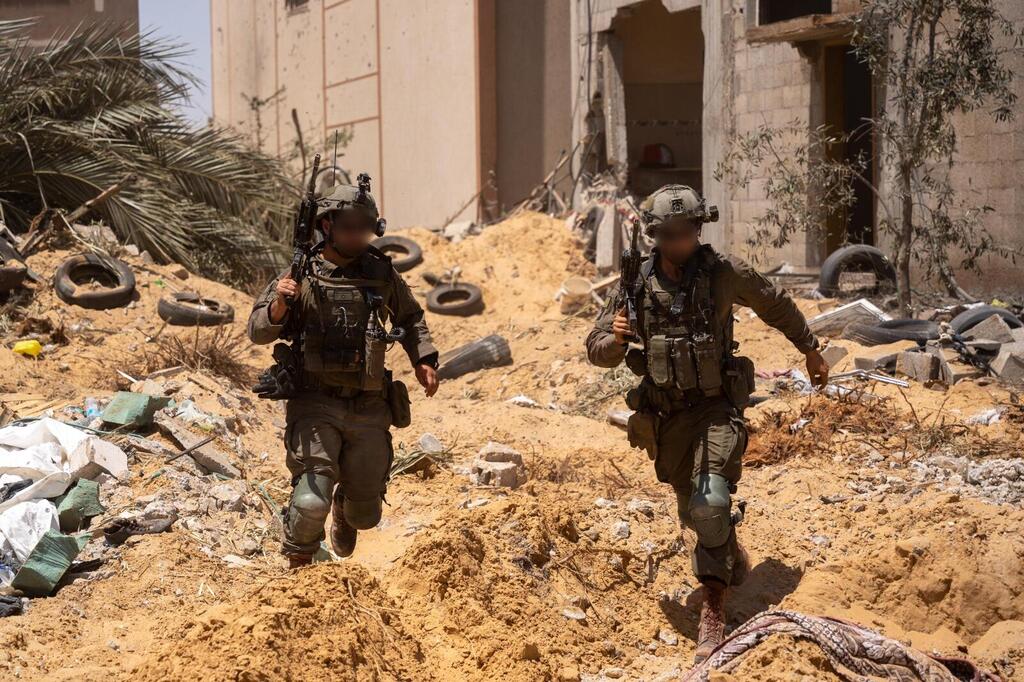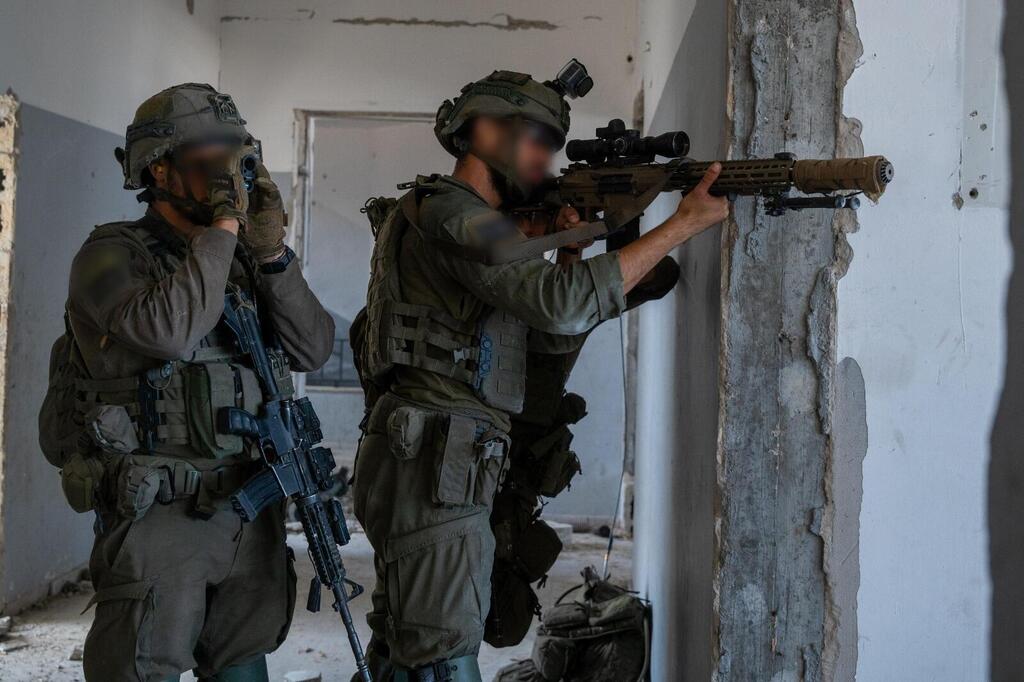The war the IDF is waging in the Gaza Strip is neither a war of survival nor one of rebirth—but it is a just war, and above all, a necessary one. It can and should be described as “the War for the Peace of the South,” because as long as Hamas and roughly half a dozen other armed Islamist jihadist factions remain active in the enclave and have the capacity to recover, physical security for residents of the Negev region will remain out of reach, and normal life will remain impossible.
4 View gallery


Staff Sgt. Yoav Raver, Sgt. Major (res.) Chen Gross, Sergeant First Class Tom Rotstein and Sergeant Uri Yhonatan Cohen
(Photo: IDF)
Their deaths were not in vain. They fell on a mission aimed at securing the release of the hostages and, more broadly, to allow residents of southern Israel to raise their children and make a living. As we assess the current fighting in Gaza, it is essential to separate political considerations from military action.
Israel has lived under the threat from Gaza since the state’s founding. It has taken a toll in blood and disrupted daily life from time to time. But in recent years—as seen in the October 7 massacre—Gaza has become an existential threat that can no longer be tolerated. This transformation is due in part to advances in military technology now accessible to any terrorist, and due in part to support from Iran and Qatar, which have turned Hamas and Palestinian Islamic Jihad (PIJ) into hybrid terrorist armies.
Gaza has become a hub for manufacturing weapons and explosives and a vast warehouse for them—most crucially, all of it underground. A sprawling tunnel network, built beneath nearly the entire territory, has largely shielded the terrorists from the IDF’s advantages in intelligence, precision airstrikes and armored combat teams.
During the ground operations through June 2024, the IDF succeeded in dismantling the organized fighting forces of Hamas and PIJ. It killed many of their most skilled and experienced fighters and destroyed most of their strategic tunnels and long-range rocket systems. Yet even now, Hamas retains control over roughly 70 percent of its network—combat tunnels run beneath nearly every neighborhood in Gaza, storing hundreds of rockets, RPGs and explosive devices.
Gaza is also littered with IDF ordnance, making explosive materials easily available. These resources allow the terror groups to wage guerrilla warfare using a few hundred veteran fighters and scores of children they have armed and deployed as cannon fodder to lay explosives.
IDF strikes terrorists carrying a concealed explosive device in Gaza
(Video: IDF)
The conclusion is clear: Hamas, PIJ and the Popular Resistance Committees remain dangerous. If allowed to rebuild, they could—within five to ten years—reestablish an underground threat that would again make life unbearable for southern Israeli communities.
Whether a Palestinian state is established or an international authority governs the territory, the threat remains the same. If Hamas retains even part of its subterranean infrastructure after the war, it will continue to pose an intolerable threat to Israel, particularly the south.
Therefore, alongside the military pressure it is applying to secure the hostages’ release, the IDF must dismantle and render inoperable Hamas’ underground network in a way that prevents its reconstruction. This is the army’s primary mission, which must be pursued with extreme caution to avoid harming the hostages. If the IDF succeeds in neutralizing the tunnel system, Hamas will lose its ability to fire long-range rockets and mortars or to stage surprise attacks on Israeli roads.
Today, the IDF has no difficulty maneuvering throughout the Gaza Strip. Hamas shows little willingness to confront Israeli forces, and direct resistance is rare. However, reaching the underground tunnel system and destroying it requires soldiers to first locate and expose the shafts that lead to it—shafts that are typically hidden inside homes and expertly concealed. As a result, the working assumption is that in every home—referred to in military terms as a “target”—where Hamas activity is detected, there is likely at least one tunnel shaft, if not more, beneath it.
Hamas has studied IDF operational tactics and knows that troops will enter these buildings. Consequently, it rigs the structures and their surroundings with explosives. Sometimes a single large device is planted on the approach route to a target; other times, multiple charges are placed both inside and around the house. Often, the explosives are hidden in walls and designed for remote detonation—either by wireless signal or motion detectors.
There is no point in cataloging the wide array of creative methods Hamas operatives have devised to booby-trap homes and roads. In many cases, they maintain visual surveillance on the target house and trigger the explosives using a wire or remote device. In rarer instances, a terrorist cell lies in wait on an upper floor, ambushing troops as they ascend narrow staircases.
The simplest way to protect soldiers is by demolishing the building—either with an airstrike or using an armored D9 bulldozer. This neutralizes the explosives but has a major drawback: once the building collapses, the tunnel shafts beneath it are extremely difficult, if not impossible, to locate. For that reason, the IDF avoids demolishing homes that, based on intelligence, may conceal tunnel shafts. Instead, it sends in troops to search the premises—such was the case on Friday, when Maglan and Yahalom fighters entered a building believed to contain tunnel access points.
The IDF is acutely aware of the dangers involved in entering buildings that may be rigged with explosives. To mitigate the risk, it uses a variety of measures, including heavy fire on suspected buildings without completely destroying them, and deploying dogs, miniature drones, robots and other classified technologies.
Still, despite these precautions, the forces are not always able to detect or neutralize the explosives, and the cost is often measured in lives. The threat of improvised explosive devices (IEDs) is likely to persist for some time and is not unique to Gaza. The U.S. military encountered a similar challenge in Iraq and Afghanistan, and was never able to fully resolve it—relying instead on reinforced vehicles to reduce casualties.
In Gaza, however, the threat often comes from within homes. Terrorists quickly plant explosives when they see IDF units approaching, and also booby-trap roads and routes newly opened by Israeli forces. Gaza’s sandy, clay-rich soil makes it easy to dig and conceal explosives. To avoid detection by Israeli UAVs and drones, terrorists wrap themselves in blankets to obscure their heat signatures, toss explosive charges into pits with crude detonation systems and cover them with soil.
When rigging houses, they have more time and greater creative freedom, since aerial surveillance is less effective indoors. Explosive materials are plentiful in Gaza—either locally produced from simple chemicals still available in Gaza or salvaged from unexploded Israeli ordnance. The IDF uses a range of technologies, including systems designed to detect Hamas lookouts or shake a building to test for structural instability without collapsing it—so as not to bury potential tunnel shafts.
Even with all these methods, casualties remain a grim reality. The process is slow and demands extreme patience. Yet public and media pressure on the IDF can unintentionally jeopardize these complex operations by pushing for faster results—potentially putting soldiers at greater risk.
On this matter, one point must be made clear: the IDF must destroy the underground infrastructure of Hamas and PIJ in the Gaza Strip. Without such action, these murderous organizations could rebuild their production systems beneath the surface and dig new combat tunnels within just a few years. No foreign entity or Palestinian authority that may control the enclave in the future will be able to do this in place of the IDF—what has happened in Lebanon is proof of that.
In Lebanon, Israel destroyed the bulk of Hezbollah’s underground network, both near the border and deeper within the Beqaa Valley. As a result, Israel is now able to maintain and complete the job through air strikes targeting what remains or what the Shiite terror group attempts to rebuild. In Gaza, the situation has not yet reached that stage—about 70 percent of the underground infrastructure remains intact. Therefore, it must be dismantled before any shift to remote operations can be considered.
Even if, after the war, an Arab-American force is deployed in Gaza, such a mission would face tremendous difficulty, primarily because of the ease with which Gaza’s soft soil allows for rapid excavation and underground construction.
If there is reliable evidence that Hamas is prepared to release all the hostages—both living and deceased—in exchange for a ceasefire, then Israel must accept such a deal, however bitter. But it must also ensure that the underground network, including production facilities and combat tunnels, is completely destroyed.
As long as Israel's government is unable to secure the return of all hostages through diplomatic channels, the IDF must continue its intense operations to eliminate as much of the subterranean network as possible. The military will develop additional methods to protect its forces from explosives—and in this context, under no circumstances should troop safety be sacrificed for the sake of operational speed.






